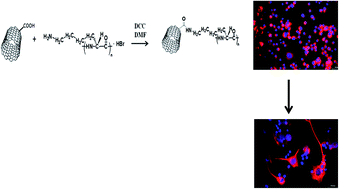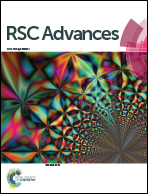Functionalized single walled carbon nanotubes facilitate efficient differentiation of neuroblastoma cells in vitro
Abstract
Single-walled carbon nanotubes (SWNTs) have been increasingly used as scaffolds for neuronal growth and differentiation. In this report, we have investigated how biocompatible functionalized SWNTs can affect the neuronal growth and morphology of an established neuronal cell line neuro2a (N2a). Interestingly, SWNTs covalently attached with biocompatible poly-D-lysine (PDL), facilitate neuronal growth and differentiation, neuronal growth on SWNTs with a combination of poly-ethylene glycol (PEG) with laminin (LA), a positive control molecule, is also studied. As expected, the mean length of the dendritic processes and axons is significantly larger with PDL as well as PEG–LA functionalized SWNTs compared to the control molecules. Most importantly, N2a cells retain neuronal morphology in the culture for a longer time (21 days) in presence of SWNT–PDL or SWNT–PEG LA, compared to the control culture. SWNTs modified neuronal cells in culture are infected with enhanced green fluorescent protein (EGFP) tagged recombinant neurotropic mouse hepatitis virus (MHV) to demonstrate that SWNT modulated N2a cells are a promising substrate for understanding the viral antigen spread and persistence as a proof of hypothesis.


 Please wait while we load your content...
Please wait while we load your content...